Accepted Scientific Name: Ferocactus cylindraceus (Engelm.) Orcutt
Cactography 1926(1): 5. Orcutt
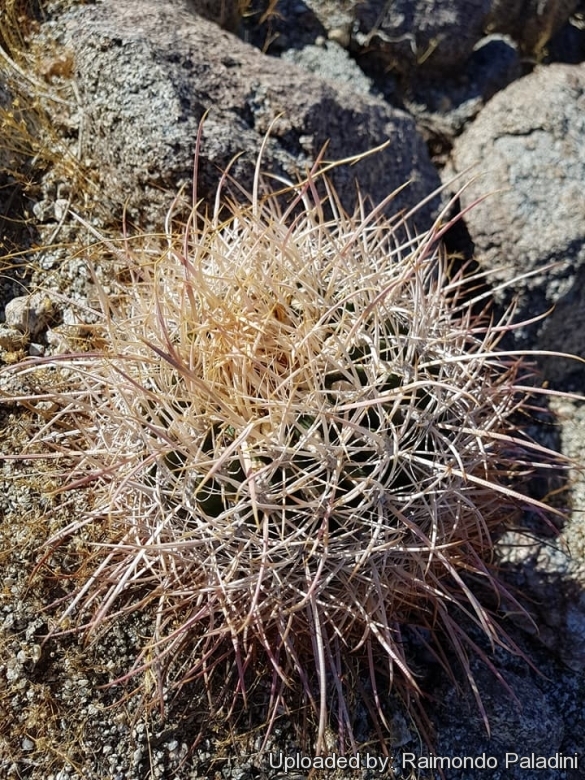
Ferocactus acanthodes f. albispinus Photo by: Raimondo Paladini
A white spined specimen near Borrego Springs, California, USA.
Origin and Habitat: Garden origin.
Synonyms:
See all synonyms of Ferocactus cylindraceus
Description: This is the rare white spined form of Ferocactus acanthodesSN|10113]]SN|10113]]. The plant is usually unbranched, forming a single column up to 2 (3) m tall and 30cm in diameter. The ribs are 2.5cm high and tuberculate.
Spines: A large central spine and three auxiliary centrals form a crucifix shape, The primary central is 7-15, angles down and is slightly to moderately hooked, sometimes to 90 degrees. The other centrals are from 5 to 7.5 cm long. The centrals are noticeably ring ridged and flattened, with a flat upper surface and rounded lower surface. Spines are pure white to very light grey (often shaded with pink, but only in the new growth).
Flowers: Yellow flowers tinged with red appear in May and June at the crown of the plant, 4 to 6cm. The fruit with scales is fleshy, yellow or yellowish green 5cm long, 2.5cm in diameter.
The flowers on all subspecies are yellow.
Subspecies, varieties, forms and cultivars of plants belonging to the Ferocactus cylindraceus group
 Ferocactus acanthodes (Lem.) Britton & Rose: Plants with a central spine 7-15 cm in length, they usually inhabits the 50-700 m elevational range. (Rejected name same as Feroctus cylindraceus)
Ferocactus acanthodes (Lem.) Britton & Rose: Plants with a central spine 7-15 cm in length, they usually inhabits the 50-700 m elevational range. (Rejected name same as Feroctus cylindraceus) Ferocactus acanthodes f. albispinus hort.: White spined type. Selected cultivated form.
Ferocactus acanthodes f. albispinus hort.: White spined type. Selected cultivated form. Ferocactus acanthodes var. rostii (Britton & Rose) W.T.Marshall: has columnar stems up to 3 m high and 30 cm in diameter. It is similar to F. acanthodes, but the stem is thinner and the spines are more curved and blanch to golden in maturity. Distribution: Texas and California.
Ferocactus acanthodes var. rostii (Britton & Rose) W.T.Marshall: has columnar stems up to 3 m high and 30 cm in diameter. It is similar to F. acanthodes, but the stem is thinner and the spines are more curved and blanch to golden in maturity. Distribution: Texas and California. Ferocactus acanthodes f. variegatus hort.: varigated form.
Ferocactus acanthodes f. variegatus hort.: varigated form.  Ferocactus cylindraceus (Engelm.) Orcutt: Colourfull barrel cactus forming in age a mound of thorns and then a narrow column up to 2m tall, with attractive curved spines that partly obscure the green stem. The spine colour is red but also yellow or pale grey. Distribution: southern California, southwestern Arizona, northern Baja California, and northwestern Sonora.
Ferocactus cylindraceus (Engelm.) Orcutt: Colourfull barrel cactus forming in age a mound of thorns and then a narrow column up to 2m tall, with attractive curved spines that partly obscure the green stem. The spine colour is red but also yellow or pale grey. Distribution: southern California, southwestern Arizona, northern Baja California, and northwestern Sonora. Ferocactus cylindraceus subs. eastwoodiae (L.D.Benson) N.P.Taylor: Plants solitary, short to tall cylindrical up to 3 m high and 30 cmin diameter. Spines dense, partly obscuring the stems, yellowish to straw colored. Distribution: restricted to central Arizona and the Grand Canyon.
Ferocactus cylindraceus subs. eastwoodiae (L.D.Benson) N.P.Taylor: Plants solitary, short to tall cylindrical up to 3 m high and 30 cmin diameter. Spines dense, partly obscuring the stems, yellowish to straw colored. Distribution: restricted to central Arizona and the Grand Canyon. Ferocactus cylindraceus var. hertrichii (Weinberg) hort.: Usually unbranched forming a single column up to 2 m tall and 30cm in diameter. It has a large central spine and three auxiliary centrals form a crucifix shape.
Ferocactus cylindraceus var. hertrichii (Weinberg) hort.: Usually unbranched forming a single column up to 2 m tall and 30cm in diameter. It has a large central spine and three auxiliary centrals form a crucifix shape. Ferocactus cylindraceus subs. lecontei (Engelm.) N.P.Taylor: Plant with untwisted non-hooked central spines 5-7 cm in length often closely pressed to the stem; Distribution: southern Nevada, southwestern Utah, southern California, and much of Arizona. Grows at 700-1500 m in elevation.
Ferocactus cylindraceus subs. lecontei (Engelm.) N.P.Taylor: Plant with untwisted non-hooked central spines 5-7 cm in length often closely pressed to the stem; Distribution: southern Nevada, southwestern Utah, southern California, and much of Arizona. Grows at 700-1500 m in elevation. Ferocactus cylindraceus var. tortulispinus (H.E.Gates) Bravo: It has much shorter stems, often with flattened tips. the spines are very twisted gray. Distribution: northern Baja California.
Ferocactus cylindraceus var. tortulispinus (H.E.Gates) Bravo: It has much shorter stems, often with flattened tips. the spines are very twisted gray. Distribution: northern Baja California.
Bibliography: Major references and further lectures
1) James Cullen, Sabina G. Knees, H. Suzanne Cubey “The European Garden Flora Flowering Plants: A Manual for the Identification of Plants Cultivated in Europe, Both Out-of-Doors and Under Glass” Cambridge University Press, 11/Aug./2011
2) David Hunt, Nigel Taylor “The New Cactus Lexicon” DH Books, 2006 ISBN 0953813444, 9780953813445.
3) Edward F. Anderson “The Cactus Family” Timber Press, 2001
4) Nathaniel Lord Britton, Joseph Nelson Rose “Cactaceae: Descriptions and Illustrations of Plants of the Cactus Family” Courier Dover Publications, 1963
 Ferocactus acanthodes f. albispinus Photo by: Raimondo Paladini
Ferocactus acanthodes f. albispinus Photo by: Raimondo Paladini A white seedling found in a batch (Locality of origin Scissor's Crossing, San Diego County, California, USA) Photo by: Valentino Vallicelli
A white seedling found in a batch (Locality of origin Scissor's Crossing, San Diego County, California, USA) Photo by: Valentino Vallicelli Ferocactus acanthodes var albispinus, habitat, near Borrego Springs, California, USA. Photo by: Raimondo Paladini
Ferocactus acanthodes var albispinus, habitat, near Borrego Springs, California, USA. Photo by: Raimondo Paladini Ferocactus acanthodes var albispinus, habitat, near Borrego Springs, California, USA. Photo by: Raimondo Paladini
Ferocactus acanthodes var albispinus, habitat, near Borrego Springs, California, USA. Photo by: Raimondo Paladini Ferocactus acanthodes f. albispinus Photo by: Cactus Art
Ferocactus acanthodes f. albispinus Photo by: Cactus Art Ferocactus acanthodes f. albispinus Photo by: Peiffer Clement
Ferocactus acanthodes f. albispinus Photo by: Peiffer Clement Ferocactus acanthodes var albispinus, Borrego Springs, California, USA. Photo by: Raimondo Paladini
Ferocactus acanthodes var albispinus, Borrego Springs, California, USA. Photo by: Raimondo Paladini Ferocactus acanthodes var albispinus, Borrego Springs, California, USA. Photo by: Raimondo Paladini
Ferocactus acanthodes var albispinus, Borrego Springs, California, USA. Photo by: Raimondo PaladiniCultivation and Propagation: Ferocactus acanthodesSN|10113]]SN|10113]] are summer-growing and pretty easy plants.
Growing rate: Thought slow to start the speed when they reach about five cm in diameter. Plant in good conditions will start to bloom when reach the diameter of only 15-18 cm.
Soil: They are suited for any rich, well drained soil such us clay, pumice, lava grit, and only a little peat or leaf-mould.
Repotting: If potted, repot them preferably in the spring, if their roots become cramped. Generally, they should be repotted every other year in order to provide fresh soil. However, this doesn't necessarily mean they'll need larger containers. Fill about a quarter of the pot with broken crocks, gravel, etc. to promote good drainage. After repotting, do not water for a week or more.
Watering: Water regularly during the aestival growth cycle (this plant need plenty of water, but do not overwater and let their soil dry out between waterings), and also needs to be avoided wetting the body of this plant while it is in sunlight. A wet cactus in the sun light can cause sun burning which can lead to scars or even fungal infections and death, keep rather dry in winter. No water should ever be allowed to stand around the roots.
Fertilization: Feed with a high potassium fertilizer in summer.
Exposure: Outside they need a bright exposure, full sun or half shade in summer if the location is exceedingly hot or bright, inside needs bright light, and some direct sun. It can tolerate moderate shade, and a plant that has been growing in shade should be slowly hardened off before placing it in full sun as the plant will be severely scorched if moved too suddenly from shade into sun.
Frost Tolerance: Light frost protection required for safe cultivation, but can tolerate sporadic light frost. This plants need a period of cool rest in winter to produce flowers abundantly.
Diseases and pests: Watch for infestations of mealybug, scale insects and spider mite.
Propagation: Seeds are the only way of reproducing. Seed Collecting: Permit fruit to ripen. Fruit must be significantly overripe before harvesting seed; clean and dry seeds.
Your Photos
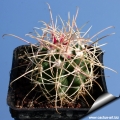
by Cactus Art
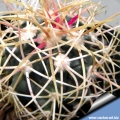
by Cactus Art

by Valentino Vallicelli
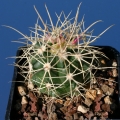
by Valentino Vallicelli
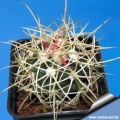
by Cactus Art























